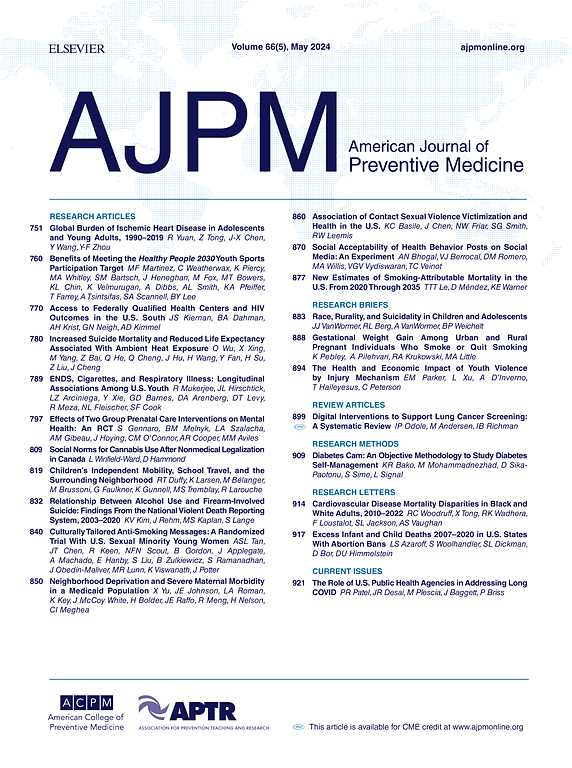预防亲密伴侣谋杀-自杀:虐待关系中有自杀倾向男性的病例对照研究。
IF 4.5
2区 医学
Q1 MEDICINE, GENERAL & INTERNAL
引用次数: 0
摘要
谋杀后自杀是一个罕见但严重的公共卫生问题。它经常发生在亲密伴侣暴力(IPV)的背景下;在美国,62%的谋杀后自杀案件涉及杀害亲密伴侣。本研究的目的是在有自杀史的男性中确定亲密伴侣谋杀-自杀的风险指标。方法:本病例对照研究使用2019-2020年国家暴力死亡报告系统(NVDRS)数据。男性的亲密伴侣谋杀-自杀案件。对照组是实施过IPV但没有杀死伴侣而自杀的男性。研究小组审查了NVDRS的文本摘要,以编码每个事件的详细信息。分析使用广义估计方程估计了亲密伴侣谋杀-自杀的调整几率,并于2024年11月完成。结果:在478对匹配的病例/对照中,枪支使用(aOR:5.3)和已故军事史(aOR:1.8)与实施亲密伴侣谋杀-自杀的几率增加有关。先前参与家庭暴力保护令(aOR:0.4)和先前确定的自杀风险指标(例如,表现出抑郁[aOR:0.4],先前的自杀企图[aOR:0.2],披露的自杀意图[aOR:0.2])与亲密伴侣谋杀-自杀的几率降低有关。结论:有自杀倾向的男性自杀行为中,有几个因素区分了谋杀-自杀的风险与仅自杀的风险。改善家庭暴力保护令的可及性和执行情况,同时从实施IPV的人手中拿走枪支,可以防止亲密伴侣谋杀-自杀。也可能有机会在军事、医疗、法律和儿童福利机构中筛查和共同解决自杀和IPV犯罪问题。本文章由计算机程序翻译,如有差异,请以英文原文为准。
Preventing Intimate Partner Murder–Suicide: A Case-Control Study of Suicidal Males in Abusive Relationships
Introduction
Murder–suicide is a rare but serious public health problem. It often occurs in the context of intimate partner violence; 62% of murder–suicides in the U.S. involve killing an intimate partner. The goal of this study was to identify the risk indicators for intimate partner murder–suicide among suicidal males with a history of perpetrating intimate partner violence.
Methods
This case-control study used National Violent Death Reporting System data, 2019–2020. Cases were intimate partner murder–suicides committed by males. Controls were males who perpetrated intimate partner violence but who died by suicide without killing their partner. The research team reviewed text summaries from the National Violent Death Reporting System to code detailed information about each event. Analyses estimated the adjusted odds of intimate partner murder–suicide using generalized estimating equations and were completed in November 2024.
Results
Among 478 matched case/control pairs, firearm use (AOR=5.3) and decedent military history (AOR=1.8) were associated with increased odds of perpetrating intimate partner murder–suicide. Prior involvement in a domestic violence protection order (AOR=0.4) and previously established suicide risk indicators (e.g., appearing depressed [AOR=0.4], prior suicide attempts [AOR=0.2], disclosed suicidal intent [AOR=0.2]) were associated with decreased odds of intimate partner murder–suicide.
Conclusions
Among suicidal males perpetrating intimate partner violence, several factors differentiated the risk for murder–suicide relative to that of suicide only. Improving accessibility and implementation of domestic violence protection orders while removing firearms from people who are perpetrating intimate partner violence may prevent intimate partner murder–suicide. There may also be opportunities to screen for and jointly address suicidality and intimate partner violence perpetration across military, healthcare, legal, and child welfare settings.
求助全文
通过发布文献求助,成功后即可免费获取论文全文。
去求助
来源期刊

American Journal of Preventive Medicine
医学-公共卫生、环境卫生与职业卫生
CiteScore
8.60
自引率
1.80%
发文量
395
审稿时长
32 days
期刊介绍:
The American Journal of Preventive Medicine is the official journal of the American College of Preventive Medicine and the Association for Prevention Teaching and Research. It publishes articles in the areas of prevention research, teaching, practice and policy. Original research is published on interventions aimed at the prevention of chronic and acute disease and the promotion of individual and community health.
Of particular emphasis are papers that address the primary and secondary prevention of important clinical, behavioral and public health issues such as injury and violence, infectious disease, women''s health, smoking, sedentary behaviors and physical activity, nutrition, diabetes, obesity, and substance use disorders. Papers also address educational initiatives aimed at improving the ability of health professionals to provide effective clinical prevention and public health services. Papers on health services research pertinent to prevention and public health are also published. The journal also publishes official policy statements from the two co-sponsoring organizations, review articles, media reviews, and editorials. Finally, the journal periodically publishes supplements and special theme issues devoted to areas of current interest to the prevention community.
 求助内容:
求助内容: 应助结果提醒方式:
应助结果提醒方式:


